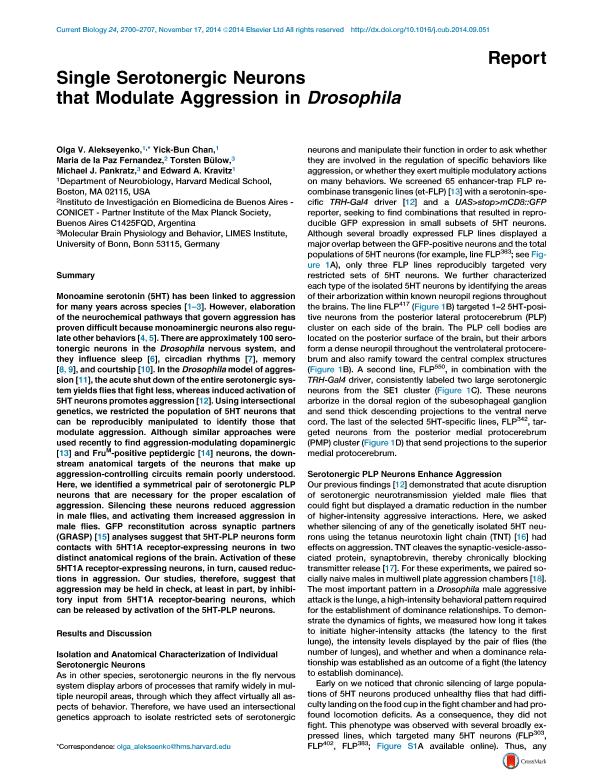Mostrar el registro sencillo del ítem
dc.contributor.author
Alekseyenko, Olga V.
dc.contributor.author
Chan, Yick Bun
dc.contributor.author
Fernandez, Maria de la Paz

dc.contributor.author
Bullow, Torsten
dc.contributor.author
Pankratz, Michael J.
dc.contributor.author
Kravitz, Edward A.
dc.date.available
2017-02-01T20:09:03Z
dc.date.issued
2014-11
dc.identifier.citation
Alekseyenko, Olga V.; Chan, Yick Bun; Fernandez, Maria de la Paz; Bullow, Torsten; Pankratz, Michael J.; et al.; Single Serotonergic Neurons that Modulate Aggression in Drosophila; Cell Press; Current Biology; 24; 22; 11-2014; 2700-2707
dc.identifier.issn
0960-9822
dc.identifier.uri
http://hdl.handle.net/11336/12307
dc.description.abstract
Monoamine serotonin (5HT) has been linked to aggression for many years across species [1-3]. However, elaboration of the neurochemical pathways that govern aggression has proven difficult because monoaminergic neurons also regulate other behaviors [4, 5]. There are approximately 100 serotonergic neurons in the Drosophila nervous system, and they influence sleep [6], circadian rhythms [7], memory [8, 9], and courtship [10]. In the Drosophila model of aggression [11], the acute shut down of the entire serotonergic system yields flies that fight less, whereas induced activation of 5HT neurons promotes aggression [12]. Using intersectional genetics, we restricted the population of 5HT neurons that can be reproducibly manipulated to identify those that modulate aggression. Although similar approaches were used recently to find aggression-modulating dopaminergic [13] and Fru(M)-positive peptidergic [14] neurons, the downstream anatomical targets of the neurons that make up aggression-controlling circuits remain poorly understood. Here, we identified a symmetrical pair of serotonergic PLP neurons that are necessary for the proper escalation of aggression. Silencing these neurons reduced aggression in male flies, and activating them increased aggression in male flies. GFP reconstitution across synaptic partners (GRASP) [15] analyses suggest that 5HT-PLP neurons form contacts with 5HT1A receptor-expressing neurons in two distinct anatomical regions of the brain. Activation of these 5HT1A receptor-expressing neurons, in turn, caused reductions in aggression. Our studies, therefore, suggest that aggression may be held in check, at least in part, by inhibitory input from 5HT1A receptor-bearing neurons, which can be released by activation of the 5HT-PLP neurons.
dc.format
application/pdf
dc.language.iso
eng
dc.publisher
Cell Press

dc.rights
info:eu-repo/semantics/openAccess
dc.rights.uri
https://creativecommons.org/licenses/by-nc-nd/2.5/ar/
dc.subject
Serotonin
dc.subject
Aggression
dc.subject
Neuronal Circuitry Mapping
dc.subject
Drosophila
dc.subject.classification
Otras Ciencias Biológicas

dc.subject.classification
Ciencias Biológicas

dc.subject.classification
CIENCIAS NATURALES Y EXACTAS

dc.title
Single Serotonergic Neurons that Modulate Aggression in Drosophila
dc.type
info:eu-repo/semantics/article
dc.type
info:ar-repo/semantics/artículo
dc.type
info:eu-repo/semantics/publishedVersion
dc.date.updated
2016-12-12T20:46:51Z
dc.journal.volume
24
dc.journal.number
22
dc.journal.pagination
2700-2707
dc.journal.pais
Estados Unidos

dc.description.fil
Fil: Alekseyenko, Olga V.. Harvard Medical School; Estados Unidos
dc.description.fil
Fil: Chan, Yick Bun. Harvard Medical School; Estados Unidos
dc.description.fil
Fil: Fernandez, Maria de la Paz. Consejo Nacional de Investigaciones Científicas y Técnicas. Oficina de Coordinación Administrativa Parque Centenario. Instituto de Investigación en Biomedicina de Buenos Aires - Instituto Partner de la Sociedad Max Planck; Argentina
dc.description.fil
Fil: Bullow, Torsten. Universitat Bonn; Alemania
dc.description.fil
Fil: Pankratz, Michael J.. Universitat Bonn; Alemania
dc.description.fil
Fil: Kravitz, Edward A.. Harvard Medical School; Estados Unidos
dc.journal.title
Current Biology

dc.relation.alternativeid
info:eu-repo/semantics/altIdentifier/url/http://www.sciencedirect.com/science/article/pii/S0960982214012147
dc.relation.alternativeid
info:eu-repo/semantics/altIdentifier/doi/http://dx.doi.org/10.1016/j.cub.2014.09.051
dc.relation.alternativeid
info:eu-repo/semantics/altIdentifier/url/http://www.cell.com/current-biology/abstract/S0960-9822(14)01214-7
dc.relation.alternativeid
info:eu-repo/semantics/altIdentifier/url/https://pubmed.ncbi.nlm.nih.gov/25447998/
Archivos asociados
